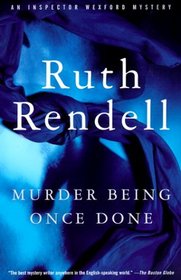Murder Being Once Done by Ruth Rendell
Review by Matt B. (BuffaloSavage)
A cemetery caretaker finds the body of the young woman in a vault, lying slumped between two stone sarcophagi. The corpse of a strangled girl is a grisly discovery, even for a neglected graveyard in a part of London that has seen much better days.
Countryman Reg Wexford, also a police inspector, finds himself convalescing in London after a health scare. Back in 1972, it seems, there was not a lot specialists could do for a thrombosis (clot) in the eye beyond prescribing rest and a punishing regimen of lo-cal food and – horrors – no alcohol.
So Reg and his wife Dora are staying with Reg’s nephew Howard Fortune, a homicide detective assigned to investigate the killing of the young woman. The nephew is over-cautious about Reg’s rest and doesn’t mention the case while Reg is annoyed and insecure by the zealous caregiving and condescension with which he is treated due to his health. Anybody who has gone through a health crisis will be able to connect with the discouragement that Reg has to bring his powers of resilience to resist.
Rendell’s mysteries hold their attractions for their blend of the timeless and the nostalgic. We have the broken families and lost youth we expect to find in classics. But these elements are clothed in mod 1960s garb, with the older generation all in a twist over the muddled, footloose lives the younger generation lead.
Rendell is never cynical or callous but she has a candid realism about unchanging human nature. More than most mystery writers, she fleshes out the background and behavior of the victim in order to give a strong sense of why-dunnint. Her characters are excellently drawn. She examines the harmless obsession of the antiquary Dearborn and the cluelessness about the world of someone raised in a narrow milieu. And, bravely for 1972, she has the openly gay character Ivan Teal deploy unkind sarcasms against Reg the Cop over the treatment of gays at the hands of the Metro Police.
And what a strange, sinister affair the story turns out to be. Reg and his London colleagues find no way to get any information about the victim. To all appearances, she had no friends, no money, no family, living in a crummy apartment under an assumed name. Nothing tangible to start the investigation. As if the stranger from the vault was just a ghost.
Written in 1972, this was the seventh mystery starring Inspector Wexford. There were to be 16 more, all solid sellers and many adapted into TV episodes.


